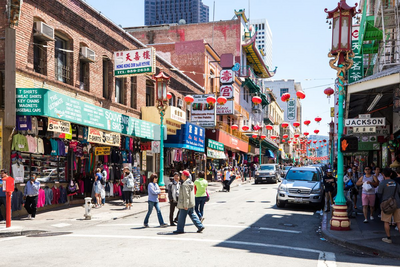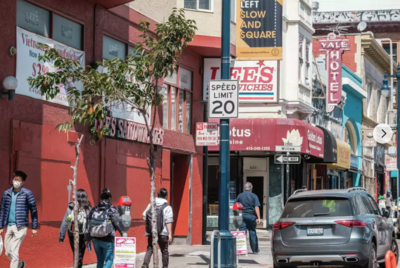4. Business Activity Districts (AB 43 change)
Newly created under AB 43, business activity districts can be established in commercial areas such as downtowns and neighborhood business corridors if the land use and roadway meet certain conditions. Roads in business activity districts may have a prima facie speed limit of 20 or 25 mph without the need for an E&TS. Refer to CVC § 22358.9 for the specific definitions of business activity districts.
Example of Business Activity District with High Pedestrian and Bike Activity
 g
g
Source: Adventure Cycling Association
To qualify as a business activity district, the following criteria should used to assess a corridor:
a. All of the following must be true: Located in commercial areas such as downtowns or neighborhood business corridors AND on a road with four or fewer travel lanes.
b. AND 1 of the following must be true:
i. A maximum posted speed limit of 30 mph before and after a proposed 25 mph business activity district. Note: it may be possible to reduce surrounding 35 mph zones to 30 mph using other criteria to allow for this option.
ii. A maximum posted speed limit of 25 mph before and after a proposed 20 mph business activity district. Note: it may be possible to reduce surrounding 30 mph zones to 25 mph using other criteria to allow for this option.
c. AND contains at least 3 out of 4 of the following:
i. At least half of the contiguous properties are for retail or dining commercial uses.
ii. On-street parking.
iii. Signals or stop signs are located at intervals of no more than 600 feet.
iv. Marked crosswalks that are not controlled by a traffic control device.
(Signage required, Exempt from certain speed trap provisions, Ordinance/resolution required, AB 43 changes)
Example of a Business District with Many Shops and High Pedestrian Activity

Source: Curbed San Francisco
Business activity districts with 20 mph or 25 mph speed limits cannot be established on roads that have leveraged any of the other AB 43 changes (see sections 5,6,7 below): further reducing the speed limit by 5 mph using the designations of “safety corridor” or “high concentrations of bicyclists or pedestrians” or when retaining the existing or restoring the immediately prior speed limit. Therefore, local jurisdictions can consider implementing 20 mph or 25 mph business activity district speed limits prior to implementing other elements of AB 43 changes.
The City of San José has implemented 20 mph business activity district speed limits on 6 corridors both in downtown and other commercial areas (City of San José 2022).
Example of a Business Activity District with Many Retail Uses

Source: San Francisco Chronicle



 g
g



